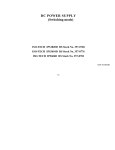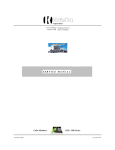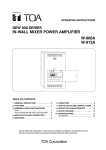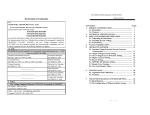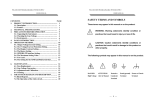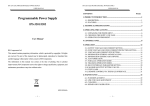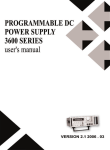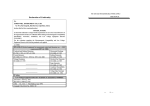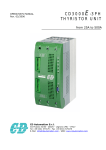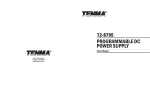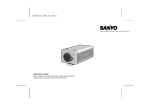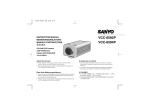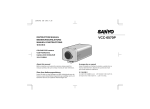Download SAFETY TERMS AND SYMBOLS
Transcript
SAFETY TERMS AND SYMBOLS These terms may appear in this manual or on the product: WARNING. Warning statements identify condition or practices that could result in injury or loss of life. CAUTION. Caution statements identify conditions or practice that could result in damage to this product or other property. WARNING: This equipment is not for measurements performed for CAT II, III and IV. Measurement category I is for measurements performed on circuits not directly connected to MAINS. Measurement category II is for measurements performed on circuits directly connected to the low voltage installation. Measurement category III is for measurements performed in the building installation. Measurement category IV is for measurements performed at the source of the low-voltage installation. The following symbols may appear in this manual or on the product: DANGER High Voltage DANGER Hot Surface ATTENTION refer to Manual i Protective Conductor Terminal Earth(ground) terminal FOR UNITED KINGDOM ONLY As the colours of the wires in main leads may not correspond with the colours marking NOTE This lead/appliance must only identified in your plug/appliance, proceed as follows: be wired by competent persons The wire which is coloured Green & Yellow must be connected to the Earth terminal marke WARNING with the letter E or by the earth symbol or coloured Green or Green & Yellow. THIS APPLIANCE MUST BE EARTHED The wire which is coloured Blue must be connected to the terminal which is marked with th Letter N or coloured Blue or Black. IMPORTANT The wires in this lead are The wire which is coloured Brown must be connected to the terminal marked with the letter coloured in accordance with or P or coloured Brown or Red. the following code: If in doubt, consult the instructions provided with the equipment or contact the supplier. Green/ Yellow: Earth This cable/appliance should be protected by a suitably rated and approved HBC mains fuse; Blue : Neutral refer to the rating information on the equipment and/or user instructions for details. As a Brown: Live guide, (Phase) cable of 0.75mm ² should be protected by a 3A or 5A fuse. Larger conductors would norma require 13A types, depending on the connection method used. Any moulded mains connector that requires removal/replacement must be destroyed by rem of any fuse & fuse carrier and disposed of immediately, as a plug with bared wires is hazard if a engaged in live socket. Any re-wiring must be carried out in accordance with the inform detailed on this label. ii EC Declaration of Conformity We GOOD WILL INSTRUMENT CO.,LTD. No. 7-1, Jhongsing Rd., Tucheng City, Taipei County 236, Taiwan GOOD WILL INSTRUMENT (SUZHOU) CO., LTD. No.69 Lushan Road, Suzhou New District Jiangsu, China. declare, that the below mentioned products SPS-1230, SPS-1820, SPS-3610, SPS-2415, SPS-606 are herewith confirmed to comply with the requirements set out in the Council Directive on the Approximation of the Law of Member States relating to Electromagnetic Compatibility (89/336/EEC, 92/31/EEC, 93/68/EEC) and Low Voltage Equipment Directive (73/23/EEC, 93/68/EEC). For the evaluation regarding the Electromagnetic Compatibility and Low Voltage Equipment Directive, the following standards were applied: EN 61326-1: Electrical equipment for measurement, control and laboratory use — EMC requirements (1997+A1: 1998+A2:2001) Conducted Emission Radiated Emission EN 55011:1998 Class A Current Harmonic EN61000-3-2: 2000 Voltage Fluctuation ----------------------------------- EN61000-3-3:1995 ------------------------------------------------- Electrostatic Discharge Radiated Immunity Electrical Fast Transients Surge Immunity Conducted Susceptibility Power Frequency Magnetic field Voltage Dip/Interruption EN 61000-4-2:1995+A1:1998 EN 61000-4-3:1996+A1:1998 EN 61000-4-4:1995 EN 61000-4-5:1995 EN 61000-4-6:1996 EN 61000-4-8:1993 EN 61000-4-11:1994 Low Voltage Equipment Directive 73/23/EEC & amended by 93/68/EEC Low Voltage Directive IEC/ EN 61010-1: 2001 iii CONTENTS 1. INTRODUCTION.....................................................................................................................................................................1 2. SPECIFICATION .....................................................................................................................................................................2 2-1. GENERAL ..............................................................................................................................................................................2 2-3. CONSTANT CURRENT OPERATION ........................................................................................................................................3 2-4. INDICATOR METER ...............................................................................................................................................................3 2-5. OVER VOLTAGE PROTECTION ...............................................................................................................................................3 2-6. INSULATION ..........................................................................................................................................................................3 3. PRECAUTIONS BEFORE OPERATION .............................................................................................................................4 3.1 UNPACKING THE SWITCHING POWER SUPPLY ........................................................................................................................4 3.2 CHECKING THE LINE VOLTAGE ..............................................................................................................................................4 3.3 ENVIRONMENT .......................................................................................................................................................................5 3.4 EQUIPMENT INSTALLATION, AND OPERATION........................................................................................................................5 4. THEORY OF OPERATION (SEE FIGURE 4-1) ..................................................................................................................6 5. PANEL CONTROLS AND INDICATORS ............................................................................................................................9 5-1. FRONT PANEL........................................................................................................................................................................9 5-2. REAR PANEL .........................................................................................................................................................................9 6. OPERATION INSTRUCTIONS ...........................................................................................................................................12 6-1. PRECAUTION .......................................................................................................................................................................12 6-2. SETTING CURRENT LIMIT....................................................................................................................................................15 6-3. CONSTANT VOLTAGE / CONSTANT CURRENT CROSSOVER CHARACTERISTIC.....................................................................15 6-4. OPERATION MODE: VOLTAGE OPERATION MODE ...............................................................................................................16 6-5. REMOTE ERROR SENSING ...................................................................................................................................................16 6-6. REMOTE CONTROL..............................................................................................................................................................18 6-7. OVP SETTING .....................................................................................................................................................................18 7. MAINTENANCE ....................................................................................................................................................................19 7-1. FUSE REPLACEMENT ...........................................................................................................................................................19 7-2. LINE VOLTAGE CONVERSION ..............................................................................................................................................19 7-3. INTERNAL ADJUSTMENTS ....................................................................................................................................................20 7-4 CLEANING ............................................................................................................................................................................22 iv 1. INTRODUCTION The series of switching power supplies for measuring instrument have ruled out the inconvenience of big volume and heavyweight of a traditional power supply possess. The output voltage and current is controlled by two variable resistors with coarse and fine regulation for more handy and precise adjustment. Features: z z z z z z With more extensive range of input voltage at 97V~133V (for 115V) and 195V~265V (for 230V). With high frequency operation can reduce the size of power transformer. With small size, light weight and high density power. Entire efficiency rate higher up to 70%. Auto control the voltage and current mode. Zero adjustment for the output of voltage and current. 1 2. SPECIFICATION 2-1. General Main supply Rating, dimension and weight : 115V/230V±15% 50/60Hz (Switch selectable). : See Table 2-1. Table 2-1 MAX. RATING INPUT RATING Voltage Current Watts VA SPS-1230 12V 30A SPS-1820 18V 20A SPS-2415 24V 15A 500 900 SPS-3610 36V 10A SPS-606 60V 6A Dimensions:128(W) × 145(H) × 285(D) mm. Model FUSE STYLE & RATING 115V 230V T 10A 250V T 6.3A 250V WEIGHT kg 3.3 WARNING: Voltage over 60V DC is a lethal shock hazard to the user. Be careful when connecting power supplies in series to achieve voltage higher than 60V DC totally or 60V DC between any connection and earth ground. Operation Environment : Indoor use, Altitude up to 2000m, Installation Category II, Pollution degree 2. Operation Temperature &Humidity : 0℃ to 40℃, <80%. Storage Temperature & Humidity : -10℃ to 70℃, <70%. Accessories : Test Lead (current < 4A)…………………………………………… × 1 Operation Manual..…………………………………………………………. × 2 1 2-2. Constant Voltage Operation (1) Output Voltage ranges from 0 to rating voltage with continuous adjustment. (2) Voltage regulation line regulation≦5mV. load regulation≦5mV. (3) Recovery time≦500μs(50% Load change, minimum load 0.5A). (4) Ripple & Noise≦5mVrms, 100mVp-p (tested by 20MHz oscilloscope.) (5) Temperature coefficient≦100ppm/℃. 2-3. Constant Current Operation (1) Output current ranges from 0 to rating current with continuous adjustment. (2) Current regulation line regulation≦3mA. load regulation≦3mA. (3) Ripple & Noise SPS-606 SPS-3610 SPS-2415 SPS-1820 ≦3mArms ≦5mArms ≦10mArms 2-4. Indicator Meter 1)Voltage: Display : 3 1/2 Digits 0.39” Green LED display. Accuracy : ±(0.5% of rdg + 2 digits). 2)Current: Display : 3 1/2 Digits 0.39” Red LED display. Accuracy : ±(0.5% of rdg + 2 digits). 2-5. Over Voltage Protection (1) Over Voltage Protection ranges from 5% rating to rating +5.5%. (2) OVP Accuracy ±(Vset 1%+0.6V) 2-6. Insulation Between Chassis and Output Terminal : ≧20MΩ (DC500V). Between Chassis and AC Cord : ≧30MΩ (DC500V). 3 ≦10mArms SPS-1230 ≦30mArms 3. PRECAUTIONS BEFORE OPERATION 3.1 Unpacking the Switching Power Supply The instrument has been fully inspected and tested before shipping from the factory. Upon receiving the instrument, please unpack and inspect it to check if there is any damages caused during transportation. If any sign of damage is found, notify the bearer and/or the dealer immediately. 3.2 Checking the Line Voltage The instrument can be used with line voltages shown in the table below. Before connecting the power plug to an AC line outlet, make sure the voltage selector of the rear panel is set to the correct position and the proper fuse installed corresponding to the line voltage. The unit may be damaged if connected to the wrong AC line voltage. WARNING: To avoid electrical shock the power cord protective grounding conductor must be connected to ground. When line voltages are changed, replace the required fuses shown below. Line voltage Range Fuse Line voltage Range Fuse 115V 97-133V T 10A 250V 230V 195-250V T 6.3A 250V WARNING: To avoid personal injury, disconnect the power cord before removing the fuse holder. 4 3.3 Environment The normal ambient temperature range of this instrument is from 0° to 40°C (32° to 104°F). Operation of the instrument above this temperature range may cause damage to the circuits. Do not use the instrument in a place where strong magnetic or electric field exists as it may disturb the measurement. 3.4 Equipment Installation, and Operation Ensure there is proper ventilation for the vents in the SPS power supplies case. If this equipment is used in a manner not according to the specification, the protection provided by the equipment may be impaired. WARNING: This is a Class A product. In a domestic environment this product may cause radio interference in which case the user may be required to take adequate measures. WARNING: This equipment is not for measurements performed for CAT II, III and IV. 5 4. THEORY OF OPERATION (See Figure 4-1) z Block Configuration of SPS- System The SPS-Series comprise a Bridge rectifier, a Pulse Width Modulation, a Driver Circuit, a Driver Transformer, a Rectifier Circuit, a Voltage Control Circuit, a Current Shunt, an Output Filter, a Voltage/Current Adjusting Circuit, a Buffer Circuit, an Error Amplifier, an Opto-Isolator, and an Auxiliary Switching Supply and etc. z Component List for each circuit configuration Bridge Rectifier: BD101. Pulse Width Modulation: U102. Driver Circuit: T104, Q105~Q108. Driver Transformer: T301. Rectifier Circuit: D301,D3011. Voltage Control Circuit: Q303. Current Shunt: R341. Output Filter: Common Choke L302, C325. Voltage/Current Adjusting Circuit: U302. Buffer Circuit: U302, Q301. Error Amplifier: U301, U303. Opto-isolator: U304. Auxiliary Switching Supply: U201, U202, T201. OVP: U401, U402 Remote Control: RL401, D402 6 z Description of Circuit Theory 1) +10V Voltage reference circuit: Start up the circuits of R306 and D302 to ensure the output voltage of OPA U301, PIN 1 is in positive status when power is on. At this moment, the output voltage of PIN 1 will pass through R307 to maintain the voltage of both ends of ZENER DIODE ZD301(6.2V) to 6.2V. As OPA has the character of false short circuit, so U301 PIN3=6.2V, refer to the VR301 + R304 + R305 VR301 + 4.99k + 10k = 6.2 Vref = 6.2 ≅ 10V 10k R305 following formula: Therefore, the OPA’s output voltage can be changed by adjusting the VR301 as shown in the following formula: Vref=10V→VR301=1.14kΩ 2) Voltage Adjusting Circuit The R311, and R313 are voltage feedback attenuating resistors while R312 is to control the output of Reference voltage. Please refer to the following formula: R311 + R313 R313 If Vref=10V R311=52.3kΩ R313=20kΩ Vout = Vref 52.3k + 20k 72.3k = 10 = 36.15V 20k 20k And the R316, R317, C313, C314, and C315 are compensated circuits for voltage frequency. Vout = Vref 3) Current Adjusting Circuit: The U302 is an Error Amplifier with the gain at: Io × R341 × A = 10V × A= R326 100k = = 28.01 R342 3.57k R321 = Vpin12 = Vpin13 R321 + R322 + VR303 For example: SPS-1820, Io=20A,R341=10mΩ Vpin12=Io×R341×A=20×0.01×28.01=5.602V 7 z Figure 4-1: Block Diagram 8 5. PANEL CONTROLS AND INDICATORS 5-1. Front panel (1) CV Indicator (2) CC Indicator (3) Voltage coarse (4) Voltage fine (5) Current coarse (6) Current fine (7) “+” output terminal (8) “GND” terminal (9) “–“output terminal (10) Meter (11) Meter (12) Power control (13) Current HI/LO control Lights when the power is on and in constant voltage operation. Lights when in constant current operation. For the coarse adjustment of the output voltage. For the fine adjustment of the output voltage. For the coarse adjustment of the output current. For the fine adjustment of the output current. Positive polarity (Red) (MAX. 3A output only). Earth and chassis ground (Green). Negative polarity (Black) (MAX. 3A output only). Indicates the output voltage. Indicates the output current. On/Off switch. Current indicates HI/LO range selection. HI range: Output current range is from 0 to rating current. LO range: Output current range is from 0 to half-rating current. 5-2. Rear panel (14) Fuse holder (15) Power socket. (16) AC selects switch With 115V or 230V voltage and current ranges selection (Refer to the diagrammatic instruction to prevent mis-operating). (17) Fan Cooling fan. (18) S+ sense terminal A positive input voltage remote sense terminal. (19) S– sense terminal A negative input voltage remote sense terminal. (20) + output terminal Screw type + output terminal. (21) – output terminal Screw type – output terminal. (22) Ground terminal Screw type ground terminal (connected to case chassis). (23) Remote Control Short or open the remote control terminal for output on or off. (24) OVP ADJ Adjust trimmer VR401 to set the OVP value. (25) M+ sense terminal A positive output voltage monitor terminal. (26) nM- sense terminal A negative output voltage monitor terminal. Remark: As the front panel has 3A current limit and no remote sense terminal, it is recommended to use rear output terminal for most of the applications. 9 Fig. 5-1 Front Panel 10 Fig. 5-2 Rear Panel 11 6. OPERATION INSTRUCTIONS 6-1. Precaution (1) AC input AC input should be within the range of line voltage±15% 50/60Hz. WARNING: To avoid electrical shock, the power cord protective grounding conductor must be connected to ground. (2) Installation Avoid using the power supply in a place where ambient temperature exceeds 40℃. The heat sink located at rear of the power supply must have sufficient space for radiation. CAUTION: To prevent the instrument from damage, ensure the working environment is under 40℃ of temperature. If exceeding 40℃, please refer to the drawing shown as (3) of next page. 12 (3) Output Current/Temperature Cure Line Chart: 100% Output Current 50% (%) 20 % 0 10 20 30 40 50 60 Environment Temperature (℃) 13 (4) Output Test lead Selection: The Selection of Output Test Lead and Feedback Test Lead: For safety assurance, please select the adequate output test lead according to the following list: UL (CSA) Model 1015 TEW (Twisted Wire) Wire No. AWG Component pc/mm 24 22 20 18 16 14 12 10 11/0.16 17/0.16 21/0.18 34/0.18 26/0.254 41/0.254 65/0.254 65/0.32 Conductor Cross Section Area 2 (mm) 0.22 0.34 0.53 0.87 1.32 2.08 3.29 5.23 Outer Diameter mm 0.64 0.78 0.95 1.21 1.53 2.03 2.35 3.00 Maximum Conductive Resistor Ω/km 88.6 62.5 39.5 24.4 15.6 9.90 6.24 3.90 Permissible Current A(amp) 7.64 10.0 13.1 17.2 22.6 30.4 40.6 55.3 Remark: 1. 2. 3. 4. The ambient temperature of “Permissible Current” is at 40℃, the withstanding temperature of conductor is at 105 ℃ according to the condition of the distributed single wire. The permissible current listed as above is suggested to be used under 70%. If the feedback test leads are in need, the level above UL(CSA) AWG24, 22, 20… can be accepted. Besides, when the load is a capacitive load, please use the twine wire by twisting (+)output test lead with (S+) feedback test lead. Same way used on (-) output test lead and (S-) feedback test lead. When the current value exceeds above suggestive list, can select more wires used in parallel according to above list. 14 6-2. Setting Current Limit (1) Determine the maximum safe current for the device to be powered. (2) Temporarily short the (+) and (-) terminals of the power supply together with a test lead. (3) Rotate the COARSE VOLTAGE control away from zero sufficiently to have the CC indicator lightened. (4) Adjust the CURRENT control for the desired current limit. Read the current value on the Ammeter. (5) The current limit (overload protection) has now been preset. Do not change the CURRENT control setting after this step. (6) Remove the short between the (+) and (-) terminals and hook up for constant voltage operation. 6-3. Constant Voltage / Constant Current Crossover Characteristic The working characteristic of this series is called a constant voltage/constant current automatic crossover type. This permits continuous transition from constant current to constant voltage modes in response to the load change. The intersection of constant voltage and constant current modes is called the crossover point. Fig.6-1 shows the relationship between this crossover point and the load. For example, if the load is such that the power supply is operating in the constant voltage mode, a regulated output voltage is provided. The output voltage remains constant as the load increases, up until the point where the preset current limit is reached. At that point, the output current becomes constant and the output voltage drop is proportioned to further increases in load. The crossover point is indicated by the front panel LED indicators. The crossover point is reached when the CV indicator goes out and the CC indicator is on. Fig. 6-1 Constant Voltage/Constant Current Characteristic. 15 Similarly, crossover from the constant current to the constant voltage mode automatically occurs from a decrease in load, a good example of this would be seen when charging a 12 volt battery. Initially, the open circuit voltage of the power supply may be preset for 13.8 volts. A low battery will place a heavy load on the supply and it will operate in the constant current mode, which may be adjusted for a 1 amp charging rate. As the battery becomes charged, and its voltage approaches 13.8 volts, its load decreases to the point where it no longer demands the full 1 amp charging rate. This is the crossover point where the power supply goes into the constant voltage mode. 6-4. Operation mode: Voltage Operation Mode A. Set Power switch to “OFF” position. B. Make sure that line voltage is correct for the input power voltage. C. Plug power cord into the power outlet. D. Set Power switch to “ON” position. E. Adjust “Voltage” and “Current” control to the desired output voltage and current. F. Connect the external load to the output binding posts. Make sure both “+” and “-” terminals are connected correctly. 6-5. Remote Error Sensing A normal power supply can perform its best load regulation, line regulation, low output impedance, and low output ripple and noise, as well as the rapidly transient recovery response. Please refer to figure 6-2. If there is any test lead connected between load and output terminal, the best characters of power supply can not be shown up on the load terminal. Figure 6-2 The power supply with local error sensing 16 The function of the Remote Error Sensing can only be applied to the Constant Voltage mode as shown in Figure 6-3. The feedback point of power supply must start from the load terminal directly. Therefore, the power supply can display its function on the load terminal instead of output terminal. To compensate the voltage drop causing from the test lead, it needs to shift the voltage from the output terminal of power supply, and the voltage on the load terminal remains unchanged. A large test lead is recommended in order to reduce the voltage drop as less as better on the test lead (typical 0.5V maximum). Never use the Sense connections without connecting the normal large test lead to output terminal. Figure 6-3 The power supply with remote error sensing Error Sensing Open Protection The sensing circuit must avoid open circuit without equipping with Relay, Switch, and Connector. When the open circuit is occurred abruptly on the sensing circuit, it will cause overshoot on the output terminal. To prevent this kind of phenomenon, add small resistance R1 and R2 or replace with diode as shown in the Figure 6-4. Figure 6-4 The power supply with remote error sensing protection 17 6-6. Remote Control Short the Remote Control terminal for output ON, and open the Remote Control terminal for output OFF. 6-7. OVP Setting Firstly, adjust the OVP ADJ knob clockwise to the maximum OVP, then adjust output voltage to reach the voltage of OVP. Secondly, adjust the OVP ADJ knob counter-clockwise slowly until the OVP message appears. Then the setting value of OVP is slightly less than the OVP which you intend to set. 18 7. MAINTENANCE WARNING The following instructions are used by qualified personnel only. To avoid electrical shock, do not perform any servicing other than the operating instructions of the manual unless you are qualified to do so. 7-1. Fuse Replacement If the fuse blown, the CV or CC indicators will not light and the power supply will not operate. The fuse should not normally blow unless a problem has developed in the unit. Try to determine and correct cause of the blown fuse, then replace only with a fuse of the correct rating and type. The fuse is located on the rear panel (see Fig. 5-2). WARNING: For continued fire protection. Replace with 250V fuse of the specified type and rating, and disconnect the power cord before replacing fuse. 7-2. Line Voltage conversion The primary winding of the power transformer is tapped to permit operation from 115/230 VAC, 50/60 Hz line voltage. Conversion from one line voltage to another is done by change AC selects switch as shown in Fig. 5-2. To convert to different line voltage, perform the following procedure: (1) Make sure the power cord is unplugged. (2) Set the AC switch to the desired line voltage position. (3) The change of line voltage may also require a corresponding change of fuse value. Install correct fuse value according to the instruction shown on rear panel. 19 7-3. Internal adjustments The unit was accurately adjusted at the factory before shipment. So, readjustment is suggested only when the accuracy of circuit is affected by the repair, or when you have the reason to believe that the unit is out of accuracy. The recommended calibration device is a multi-meter with an accuracy of ±0.1% dcv or better. (GOOD WILL model GDM-8145 or equivalent). If readjustment is required, proceed the following procedure. Locations of the adjustments are shown in Fig. 6-1 and Fig.7-2. (1) Adjustment of the Rating Voltage A. Connect an accurate (±0.1%) external multi-meter to measure the dc voltage at output terminals of the power supply. B. Set the COARSE and FINE VOLTAGE controls to maximum (fully clockwise). C. Adjust trimmer VR301 for a reading on the multi-meter to be 18.50V for SPS-1820, 36.50V for SPS-3610, and 60.50V for SPS-606, 24.5V for SPS-2415, 12.5V for SPS-1230. D. Adjust trimmer pot VR2 to set the reading value of voltmeter as same as the one shown on the multi-meter.. (2) Adjustment of the rating Current A. Set the CURRENT control to HI. B. Set the COARSE and FINE CURRENT controls to minimum (fully counterclockwise). C. Set the COARSE and FINE VOLTAGE controls to the center position. D. Connect an external multi-meter to measure dc current of output terminal. E. Adjust trimmer VR304 to have a reading of –0.00A indicated on the current meter. F. Set the COARSE and FINE CURRENT controls to maximum (fully clockwise) G. Adjust trimmer VR303 for a reading on the multi-meter to be 20.10A for SPS-1820, 10.10A for SPS-3610, and 6.10A for SPS-606, 15.1A for SPS-2415, 30.1A for SPS-1230. H. Adjust trimmer VR2 to set the reading value of Amp-meter as the same as the one shown on the multi-meter. I. Set CURRENT control to LOW. J. Adjust trimmer VR310 to set the reading value of Amp-meter as 0.5 times to the rating current. K. Adjust trimmer VR401 to set the OVP value (see Fig. 7-3). 20 Fig. 7-1 Adjustment Location Fig. 7-2 Adjustment Location Fig. 7-3 Adjustment Location 21 7-4 Cleaning To clean the power supply, use a soft cloth dampened in a solution of mild detergent and water. Do not spray cleaner directly onto the instrument, since it may leak into the cabinet and cause damage. Do not use chemicals containing benzene, benzene, toluene, xylem, acetone, or similar solvents. Do not use abrasive cleaners on any portion of the instrument. 22


























